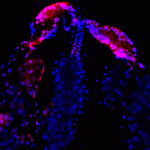Lien vers Pubmed [PMID] – 23935524
PLoS Genet. 2013;9(8):e1003621
Specific interactions between host genotypes and pathogen genotypes (G×G interactions) are commonly observed in invertebrate systems. Such specificity challenges our current understanding of invertebrate defenses against pathogens because it contrasts the limited discriminatory power of known invertebrate immune responses. Lack of a mechanistic explanation, however, has questioned the nature of host factors underlying G×G interactions. In this study, we aimed to determine whether G×G interactions observed between dengue viruses and their Aedes aegypti vectors in nature can be mapped to discrete loci in the mosquito genome and to document their genetic architecture. We developed an innovative genetic mapping strategy to survey G×G interactions using outbred mosquito families that were experimentally exposed to genetically distinct isolates of two dengue virus serotypes derived from human patients. Genetic loci associated with vector competence indices were detected in multiple regions of the mosquito genome. Importantly, correlation between genotype and phenotype was virus isolate-specific at several of these loci, indicating G×G interactions. The relatively high percentage of phenotypic variation explained by the markers associated with G×G interactions (ranging from 7.8% to 16.5%) is consistent with large-effect host genetic factors. Our data demonstrate that G×G interactions between dengue viruses and mosquito vectors can be assigned to physical regions of the mosquito genome, some of which have a large effect on the phenotype. This finding establishes the existence of tangible host genetic factors underlying specific interactions between invertebrates and their pathogens in a natural system. Fine mapping of the uncovered genetic loci will elucidate the molecular mechanisms of mosquito-virus specificity.




